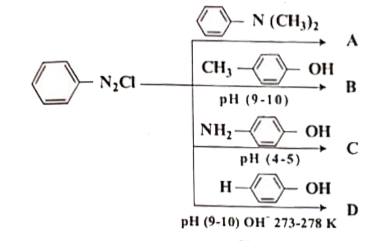Identify compound A, B and C in the following sequence of reactions.
i.
ii. Solution in Tamil

ii.
Topper's Solved these Questions
- SAMPLE PAPER - 15 (UNSOLVED ) BOOK - FULL MARKSCHAPTER - SAMPLE PAPER - 15 (UNSOLVED ) EXERCISE - PART - III
4 Videos
- SAMPLE PAPER - 15 (UNSOLVED ) BOOK - FULL MARKSCHAPTER - SAMPLE PAPER - 15 (UNSOLVED ) EXERCISE - PART - IV
6 Videos
- SAMPLE PAPER - 15 (UNSOLVED ) BOOK - FULL MARKSCHAPTER - SAMPLE PAPER - 15 (UNSOLVED ) EXERCISE - PART - IV
6 Videos
- SAMPLE PAPER - 15BOOK - FULL MARKSCHAPTER - SAMPLE PAPER - 15EXERCISE - PART - I
4 Videos
- SAMPLE PAPER - 16 ( UNSOLVED) BOOK - FULL MARKSCHAPTER - SAMPLE PAPER - 16 ( UNSOLVED) EXERCISE - PART - IV
5 Videos
Similar Questions
Mention the properties of silicones.
View Solution(i) Write the molecular formula and structural formula for the following molecules.
(a) Nitric acid (b) dinitrogen pentoxide (c ) phosphoric acid (d) phosphine
(ii) How will you manufacture sulphuric acid by contact process?
View Solution(i) Write the molecular formula and structural formula for the following molecules.
(a) Nitric acid (b) dinitrogen pentoxide (c ) phosphoric acid (d) phosphine
(ii) How will you manufacture sulphuric acid by contact process?
View SolutionRoasting os sulphide ore gives the gas (A). (A) is a colourless gas. Aqueous solution of (A) is acidic. The gas (A) is
View Solution(b) (i) Mention the uses of phosphorous ?
(ii) Why bleaching action of sulphur dioxide is temporary?
View SolutionName the following reaction. C_(6)H_(5)-C-=N overset(SnCl_(2)+HCl)rarr C_(6)H_(5)-CH=N^(o+)H_(2)]Cl^(Θ) overset(H_(2)O)rarr C_(6)H_(5)CHO+NH_(3)
View SolutionThe final product (C) of the following reaction would be : C_(6)H_(5)-underset(O)underset(||)C-C_(6)H_(5)overset(H_(2)N-OH)rarrAoverset(PCl_(5))rarrBoverset(Br_(2)//Fe)rarrC+
View SolutionGive the structures of A, B and C in the following reactions:
(i) CH3CH2INaCN−−−→AOH−−−−−−−−−−−→Partial h ydrolysisBNaOH+Br2−−−−−−−→C
(ii) C6H5N2ClCuCN−−−→AH2O/H+−−−−−→BNH3−−→ΔC
(iii) CH3CH2BrKCN−−→ALiAlH4−−−→BHNO2−−−→0∘CC
(iv) C6H5NO2Fe/HCl−−−−→ANaNO2+HCl−−−−−−−−→273KBH2O/H+−−−−−→ΔC
(v) CH3COOHNH3−−→ΔANaOBr−−−→BNaNO2/HCl−−−−−−−→C
(vi) C6H5NO2Fe/HCl−−−−→AHNO2−−−→273KBC6H5OH−−−−→C
View Solutionनिम्न अभिक्रियाओं में A, B तथा C की संरचना दीजिए -
(i) CH3CH2INaCN−−−→A¯¯¯O−−−−−−−−−−→ आंशिक जलयोजित BNaOH+Br2−−−−−−−→C
(ii) C6H5N2ClCuCN−−−→AH2O/H+−−−−−→BNH3−−→ΔC
(iii) CH3CH2BrKCN−−→ALiAlH4−−−→BHNO2−−−→0∘CC
(iv)C6H5NO2Fe/HCl−−−−→ANaNO2+HCl−−−−−−−−→273KBH2O/H+−−−−−→ΔC
(v)CH3COOHNH3−−→ΔANaOBr−−−→BNaNO2/HCl−−−−−−−→C
(vi) C6H5NO2Fe/HCl−−−−→AHNO2−−−→273KBC6H5OH−−−−→C.
View SolutionIdentify A to C in the following sequence ?
C6H5NO2Fel−−→HCIAHNO2−−−→273KBH2O−−→AC
View SolutionIdentify compounds A,B and C in the following sequence of reactions.
(i) C6H5NO2Fe/HCl−−−−→AHNO2−−−−−−→273KB−−−−→C6H3OHC
(ii) C6H5N2ClCuCN−−−→AH2O/H+−−−−−→BNH3−−→C
(iii) CH3CH2INaCN−−−→AOH−−−−−−−−−−−−→Partial hydrolysisBNaOH+Br2−−−−−−−→C
(iv). CH3NH2CH3Br−−−→ACH3COCl−−−−−→BB2H6−−→C
(v) C6H5NH2(CH3CO)2Opyridine(→)AHNO3−−−−−−−−−→H2SO4/288KBH2∅H+−−−−→C

(vii) CH3CH2NCHgO−−→AH2O−−→B(i)NaNO2/HCl−−−−−−−−−−−−→(ii)H2OC
View SolutionWhat is the end product in the following sequence of operations ?
C2H5NH2HNO2−−−→APCI5−−→BNH3−−→C
View SolutionWrite the structure of the major organic product in each of the following reactions : underset("(nitrobenzene)")(C_(6)H_(5)NO_(2))overset(Fe//HCl)rarr C_(6)H_(5)NH_(2)overset(NaNO_(2) //HCl)underset(0-5^(@)C)rarr C_(6)H_(5)N_(2)Cl overset(H_(2)O^(+))underset(Delta)rarr underset("(Phenol)")(C_(6)H_(5)OH)+N_(2)+HCl
View SolutionGive the structures of A, B and C in the following reactions : C_(6)H_(5)NO_(2) overset(Fe//HCl)(rarr)A underset(273K)overset(NaNO_(2)+HCl)(rarr)B underset(Delta)overset(H_(2)O""//H^(+))(rarr)C
View SolutionGive the structures of A, B and C in the following reactions :
C6H5NO2Fe/HCl−−−−→AHNO2−−−−−−→273KBC6H5OH−−−−→C
View Solution
